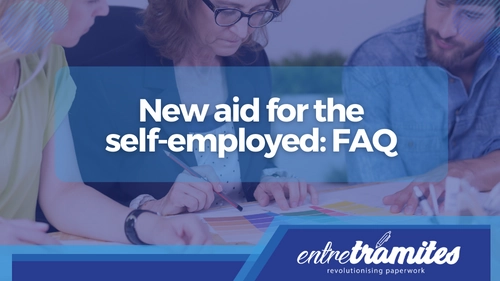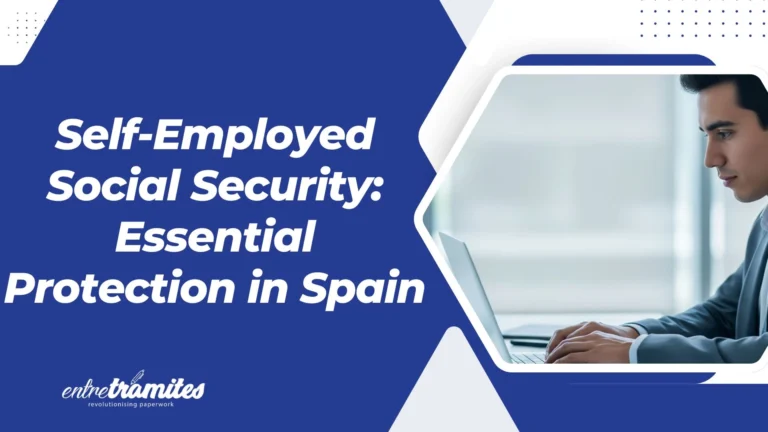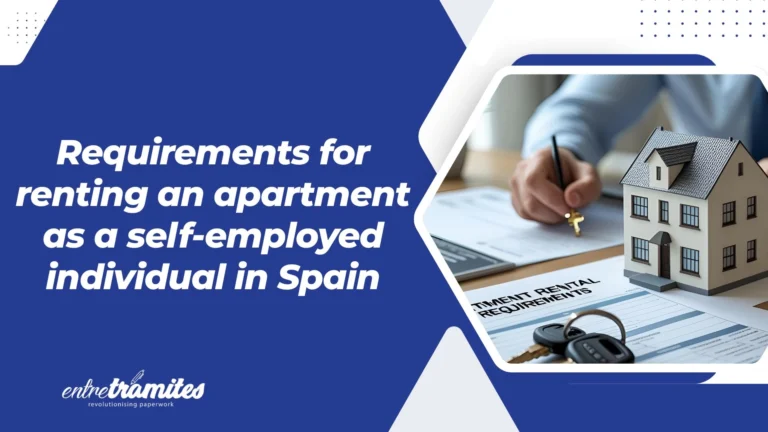On June 27, the Government published the BOE and published RDL 24/2020, which extends ERTE protection and the special benefit for the self-employed until September 30, 2020. Below we answer some questions about the new aid for the self-employed:
I am self-employed and beneficiary of the extraordinary benefit and I have resumed my activity. Do I still count on any of the new aid for self-employed workers?
Yes. As of July 1, self-employed workers who have been receiving the extraordinary unemployment benefit will automatically benefit from an exemption from Social Security contributions for the months of July, August and September.
How much am I going to pay for Social Security these months?
In July, the beneficiaries of the extraordinary unemployment benefit will not pay Social Security contributions because the exemption will be 100%. In August, half will be paid since the exemption will reach 50% in the fee, and in the September fee, they will pay 25% less than the ordinary fee.
Do I have to apply for this exemption or will it be carried out automatically?
It is not necessary to apply for the exemption, as it will be carried out automatically by the General Treasury of the Social Security in relation to all self-employed workers who stop receiving the special unemployment benefit, remain registered in the corresponding scheme and do not apply for the cessation of activity allowance.
My business is up and running but I still earn very little. Am I going to continue receiving any of the new aid for the self-employed?
The self-employed who maintain the activity but see their turnover reduced in the third quarter by 75% compared to the same period in 2019 (or their net income is lower by 1.75 times the SMI) may request the ordinary unemployment benefit.
As a novelty, seasonal self-employed workers will be able to access the extraordinary benefit until September 30 as long as their income in 2020 is 1.75 times lower than the SMI.
What does the ordinary unemployment benefit consist of?
The benefit reaches 70% of the regulatory base, that is, about 660 euros for a self-employed worker who contributes to the minimum base. To this, we must add the payment of the part of the fee corresponding to common contingencies, so the economic benefit can reach 930 euros per month.
Is the ordinary benefit compatible with maintaining the activity?
Yes, it is compatible.
Will it be deducted from my unemployment time? Will it count as consumed rights?
The ordinary unemployment benefit compatible with work will count as consumed right, so the consumed period will be discounted.
What requirements must I meet to request the ordinary unemployment benefit?
You must be affiliated and registered with the Special Regime for Self-Employed Workers or the Special Regime for Sea Workers, if applicable, and be up to date with Social Security payments. If the latter is not met, the self-employed person has thirty calendar days to pay the corresponding fees.
It is necessary to have paid contributions for cessation of activity for at least the immediately preceding 12 months on a continuous basis.
In addition, you must prove a reduction in turnover during the third quarter of 2020 of at least 75% in relation to the same period in 2019, as well as not having obtained net returns greater than €5,818.75 during those same periods. per quarter (1.75 times the SMI).
Do I have to wait until the end of the quarter to request the benefit?
It can be requested from July 1, 2020, but it will only have economic effects from that date if it is requested before July 15. If requested later, it will be effective from the day following the request.
How do I prove the drop in turnover?
In principle, a responsible declaration by the self-employed worker is sufficient to prove the drop in turnover.
However, as of October 1, 2020 and February 1, 2021, the mutual societies collaborating with Social Security, or the Social Institute of the Navy, where applicable, will collect tax data from the Ministry of Finance. the 2019 and 2020 financial years necessary for the monitoring and control of the recognized benefits.
Only in the event that the aforementioned entities cannot have access to the data held by the tax administrations, the workers must provide, within ten days following their request:
- Copy of the Value Added Tax (VAT) self-assessment form 303, corresponding to the returns for the second and third quarters of the years 2019 and 2020.
- Copy of form 130 corresponding to the self-assessment in instalment payment of the Personal Income Tax (IRPF) for the second and third quarters of the years 2019 and 2020 for the purposes of being able to determine what corresponds to the third and fourth quarters of those years.
Self-employed workers who pay Personal Income Tax (IRPF) by objective estimation (form 131) must provide the necessary documentation or any other means of proof that serves to prove the income required in this provision.
Until when will I be able to receive the benefit?
At most until September 30, 2020. From that date you can only continue to receive if you meet all the requirements established by the General Security Law.
Do I have to continue paying the fee?
Social Security contributions must continue to be paid while this benefit is received. However, the self-employed who receive this benefit will receive, in addition to its amount, the amount of contributions corresponding to common contingencies.
My business is not lifting its head and I have decided to close. Am I entitled to the benefit? During how much time?
In the event of closure, the right to unemployment benefit compatible with the work that has been recognized is maintained until the day on which the withdrawal from the regime takes effect. From that moment on, to receive unemployment benefits, the requirements established in article 330 of the consolidated text of the General Social Security Law must be accredited. .
Do I have to pay personal income tax for the extraordinary benefit? And for the cessation of activity?
Yes, you have to pay personal income tax since neither of these two benefits appears on the list of income exempt from said tax.
I have stopped meeting the requirements and I want to return the amounts that I have unduly charged, where can I do it?
To renounce the benefit, you must go to the mutual Social Security collaborator that recognized the right to it, or to the Social Institute of the Navy if it was that managing entity that recognized the right.
To return the amounts received unduly, you must also contact the mutual collaborator or, where appropriate, the Social Institute of the Navy
If I am a beneficiary of a flat rate or other bonus, will the reduction be applied to the flat rate installments or will I pay the general installments with the planned reductions for these three months and from September the flat rate will be applied to me?
During these three months, the reduction in fees will be applied to the flat or reduced rate that corresponds to the worker in each case, without in any case the reduction exceeding the fee to be paid.
Is the possibility of receiving the ordinary unemployment benefit applicable to corporate self-employed workers?
All corporate self-employed workers who have received the extraordinary unemployment benefit until June 30 and who meet the required requirements are entitled to receive this benefit.
How do we justify the drop in income of the partner requesting the benefit?
In any manner permitted by law
How and when is the new aid for the self-employed requested?
As in the case of the extraordinary benefit, the request must be made to the mutual collaborator with the Social Security that the self-employed worker has chosen.
It will begin to be received with effect from July 1, as long as the application is submitted before July 15. If it is presented later, the effects will be generated from the day after the presentation.
What documentation do I have to provide?
The application model made available by each mutual company. In this model, the mutual company may be authorized to consult the tax data for the years 2019 and 2020 necessary for the monitoring and control of the recognized benefits.
If this data query is not authorized or the mutual insurance company cannot have access to them, the worker must provide a copy of form 303 for VAT self-assessment for the second and third quarters of the years 2019 and 2020 and a copy of form 130 corresponding to the self-assessment in installment payment of personal income tax for the same periods.
Self-employed workers who pay personal income tax (IRPF) by objective estimate must provide the necessary documentation or any other means of proof that serves to prove the income required in this provision.
What if I stop meeting the requirements?
People who request this benefit can renounce it at any time before August 31, 2020. The benefit can also be returned when it is considered that the income received during the third quarter of 2020 will exceed the indicated thresholds. The collaborating mutual societies and the Social Institute of the Navy, where applicable, will carry out the corresponding verifications.
And if I am seasonal self-employed …
Am I entitled to any benefits?
Yes, as a novelty, seasonal self-employed workers are entitled to the extraordinary unemployment benefit. To do this, they must have been registered and contributing as such for at least five months between the months of October and March in the two previous years (2018 and 2019).
In addition to being up to date with payments, you must meet other requirements, such as not having been an employee for more than 120 days between March 1, 2018 and March 1, 2020. In addition, you must not have:
- Status of registration or assimilated to registration in any regime during the months of March to June 2020.
- Received no social security benefits during the months of January to June 2020, unless it was compatible with self-employment.
- Obtained income in 2020 that exceeds 23,275 euros.
– If the payment is not up to date, the self-employed person will have thirty calendar days to pay the due fees)
How much am I going to charge?
The amount of the benefit will be equivalent to 70% of the corresponding minimum contribution base.
Since when will the extraordinary benefit be received?
With effect from June 1, 2020 and will have a maximum duration of 4 months, provided that the application is submitted between July 1 and 15. Otherwise, the effects are set the day after the application is submitted.
It can also be requested at any time during the period between June 27, 2020 and October 2020.
Should I continue paying the contributions if I am granted the extraordinary benefit?
As was the case with the extraordinary benefit, during the receipt of the benefit it will not be mandatory to contribute, and the self-employed worker will remain registered.
Does it have any type of incompatibility?
The benefit will be incompatible with employed work and with any Social Security benefit that is not compatible with your registration as a self-employed worker.
The benefit will be incompatible with self-employment or self-employment if the income received during 2020 exceeds 23,275 euros.
What if at any time I no longer meet the requirements?
Self-employed workers who request this benefit may renounce it at any time before August 31, 2020. They can also return the benefit on their own initiative when they consider that the income received during the third quarter of 2020 will exceed the indicated thresholds. .
What documentation do I have to bring?
The application model made available by each mutual company in which you can authorize the mutual company to consult the tax data corresponding to the second half of 2020.
If it is not authorized or the mutual company cannot have access to them, they must provide a copy of model 390 of the annual VAT summary declaration for the year 2020 and a copy of model 130 corresponding to the self-assessment in installment payment of the Personal Income Tax (IRPF) for the fourth quarters of 2020.
Self-employed persons who pay Personal Income Tax (IRPF) by objective estimate must provide the necessary documentation to prove the income required in this provision.
SOURCE: Social Security Magazine





